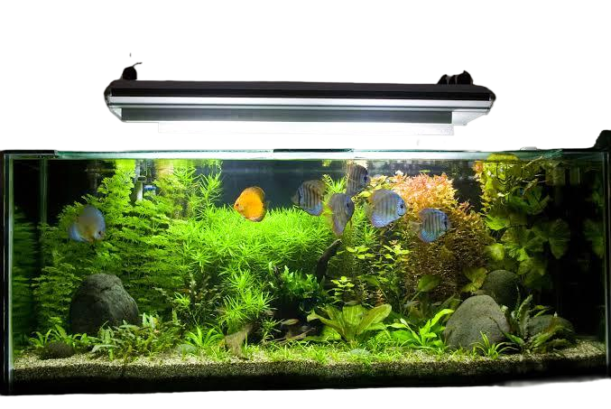Selecting the correct light for my fish tank is crucial for several reasons.
First, I want to avoid wasting money.
Some aquarium lights can be very expensive, so I need to ensure I am choosing one that fits my specific requirements.
Second, the right light can make aquarium maintenance easier.
A light that is too bright for an unplanted tank could create a significant algae problem over time.
Third, reliability is a major factor.
The last thing I want is to purchase a light for my fish tank only to have it break six months or a year later, forcing me to buy a replacement.
Why I Avoid Fluorescent Aquarium Lights
I am not going to discuss fluorescent lights because I no longer use them in my fish room.
They are bulky, generate a considerable amount of heat, and their bulbs require more frequent replacement than Light Emitting Diodes.
I also dislike that they tend to dim over time, which can negatively impact the health of plants in a planted aquarium.
For these reasons, my focus remains on Light Emitting Diode options.
The Best Light Emitting Diode Lights for an Aquarium
I will now discuss some of the lights I use based on my needs.
What is a Good Budget-Friendly Aquarium Light?
For an aquarium with no plants or only beginner-level, low-to-medium light plants, the BeamsWork lights are an excellent choice.
I have been using them more frequently in my fish room primarily because they are a budget-friendly option.
A 12-inch light costs approximately $17.
A 24-inch version, suitable for a 20-gallon tank, is about $33.
A full 48-inch light for a 55-gallon or 75-gallon tank costs around $47. The overall cost is relatively low.
I have found a couple of key benefits with the BeamsWork lights.
First, they have been very reliable; I have not had any of them break. Second, I am pleased with the color spectrum they produce.
For instance, in my Cyprichromis tank that has a BeamsWork light, I appreciate the quality of the illumination.
I have also had positive experiences with one on a 29-gallon tank and several on my 10-gallon tanks.
All of them have provided a very pleasing spectrum and color temperature.
For the price, their performance is difficult to dispute.
If I were looking for a light for a beginner tank, was unsure about my long-term commitment to the hobby, had no plants, or only had easy-to-grow plants, this would be a very good option.
Another appealing feature of the lights is the connection port for an inline timer.
Additionally, many of the lights have a switch that activates a blue moonlight setting, which is a feature many people enjoy.
What is the Best Mid-Range Aquarium Light?
The next light I highly recommend, especially for those newer to the aquarium hobby, is the Finnex Stingray.
In my fish room of approximately 70 tanks, about 50 to 55 are equipped with Finnex Stingray lights.
Many of these are the original model, but I have also had good results with the Finnex Stingray 2.
My Julidochromis tank has a Stingray 2, and it has performed just as well as the original, offering even slightly more brightness.
There is one aspect of the light I wish could be changed: its color.
I prefer my equipment to be black so it can blend in and be as inconspicuous as possible.
The silver casing is not a significant issue, but it is a personal preference.
It has been a very good light, producing beautiful color.
In fact, for its price, I am very fond of the color temperature, spectrum, and intensity of the Stingray models.
They are more expensive than the budget-oriented BeamsWork lights.
A 12-inch Finnex Stingray 2 costs about $35, which is nearly double the price of a comparable BeamsWork.
The 24-inch model is $57, and the 48-inch model is $72. The cost is almost twice that of BeamsWork.
I personally believe the Finnex Stingray offers a slightly higher quality and a more refined appearance on the tank.
Both lights will successfully grow low-light plants and most medium-light plants, and both look excellent in an unplanted tank.
Ultimately, I must decide if the improved quality is worth twice the cost.
What is the Best Light for High-Tech Planted Tanks?
What if I have plants that are more difficult to grow, require higher light levels, or I simply want more features?
At this point, I would start considering an option like the Fluval 3.0.
I have found those lights to be truly awesome, though I should expect to pay more for them.
The Fluval 3.0 has a 15-inch model for $140, a 24-inch model for $150, and a 48-inch model for $210.
While they are significantly more expensive than the other lights mentioned, they offer a wealth of features.
One major benefit is the light intensity; the lights can be very bright, making them suitable for demanding, high-light plants.
They are also fully adjustable.
I can adjust the spectrum, intensity, and timer, all through a phone application that I have found to be extremely user-friendly via its Bluetooth connection.
They have proven to be excellent lights with a slim profile that I find very appealing.
I also appreciate their darker color, similar to the BeamsWork, which helps the fixture blend in on top of my fish tank.
If I am looking for a high-quality light that can grow almost any plant and comes packed with features like cloudy day or thunderstorm modes, it is a fantastic light worth investigating.
How Can I Get a Shimmering Effect in My Aquarium?
If I am looking for a different aesthetic for my tank, a final option I use is the Kessil A160WE.
I have them on a 75-gallon tank, and they have introduced a very different look to my fish room. These are undoubtedly high-end lights.
However, the investment provides something distinct from the other options, as it is not a Light Emitting Diode strip.
The lights are also fully adjustable, allowing me to control both the spectrum and the intensity.
It is a supremely high-quality light, a fact that becomes evident from the moment I handle and install it.
It is certainly a professional-grade fixture.
I should be prepared to pay a significant amount for one. To illuminate about 24 inches of a fish tank, the cost is around $300.
For my 75-gallon setup, the total cost was somewhere between $600 and $700, depending on the chosen features.
These lights are what create a shimmering effect in a fish tank. In my tank, the effect is more pronounced because I use sponge filters, which create a great deal of surface agitation.
With a hang-on-back or canister filter, the effect would likely be more subdued.
While the constant flickering may not be for everyone, the in-person appearance is quite stunning and not as intense as one might imagine.
It is a great light that will grow any type of plant imaginable and provide a professional aesthetic, but it comes at a premium price.
How Do I Choose the Right Light for My Needs?
I must consider my specific needs when choosing an aquarium light.
If I have an unplanted tank, I can use a lower-end light and still achieve a very nice appearance.
Even for a planted tank with less demanding species, a mid-range light like the Finnex Stingray 2 is a solid choice.
If I am venturing into more advanced setups and desire full control over the spectrum, temperature, and intensity, the Fluval 3.0 is the ideal solution.
Finally, if I want to create that distinct shimmering effect, I would look at the Kessil lights.
I feel comfortable recommending these four main types of lights, given the extensive amount of time I have used them.
Conclusion
Choosing the right aquarium light depends on my tank setup, the needs of my plants, and my budget.
For low-light or unplanted tanks, I have found that budget-friendly Light Emitting Diode strips such as BeamsWork provide reliable performance, a balanced color spectrum, built-in timers, and a moonlight setting.
For a step up in both intensity and design, Finnex Stingray lights offer better brightness and a more streamlined profile, although they cost about twice as much.
In high-tech planted setups, I benefit from using the Fluval 3.0, which allows full control over spectrum and intensity through a Bluetooth-connected application.
When I want a professional-level shimmering effect, the Kessil A160WE fixture stands out with its excellent build quality and advanced customization options, making it ideal for experienced aquarists.

My name is Chibuzor Abraham Mba, and I’m the aquarist behind this website. I’ve spent years exploring the fascinating world of aquariums—especially small-scale tanks like nano and pico setups. Over time, I’ve made my fair share of mistakes, and through each one, I’ve learned valuable lessons.
